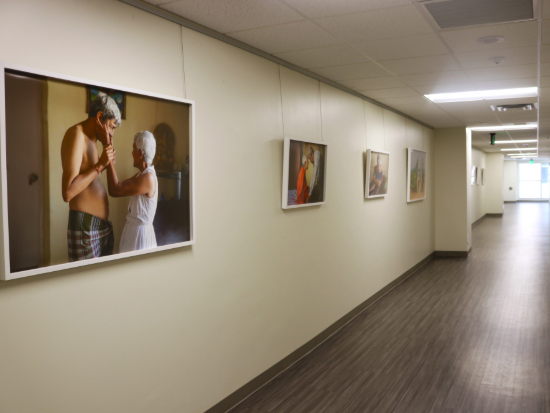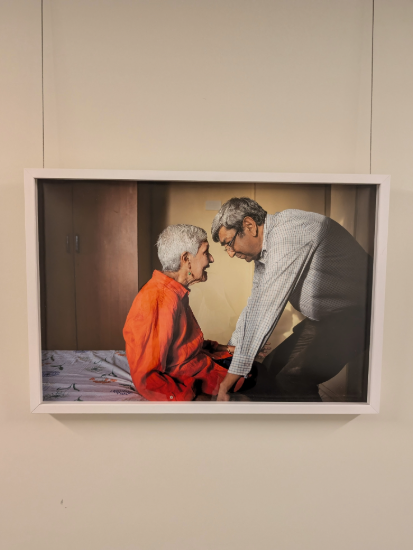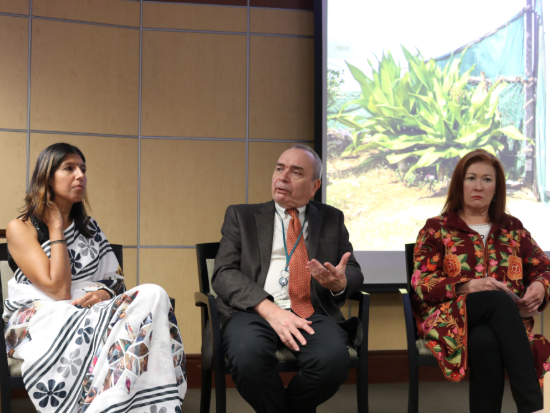 Photos lining a long corridor adjacent to the new Brain Aging and Memory Hub at UAB at first glance show a couple in love, a smiling family, and colorful scenery. Beyond the surface, however, exists a deeper implication – one not only between husband and wife, but between patient and caregiver.
Photos lining a long corridor adjacent to the new Brain Aging and Memory Hub at UAB at first glance show a couple in love, a smiling family, and colorful scenery. Beyond the surface, however, exists a deeper implication – one not only between husband and wife, but between patient and caregiver.
“I photographed my parents over a decade ago as my mother experienced frontotemporal dementia, and my father relentlessly cared for her,” writes Los Angeles-based artist Manjari Sharma. “Despite their challenges, their relationship’s endurance, love, and light are seethingly apparent in every picture.”
Sharma is the inaugural artist in residence at the UAB Brain Aging and Memory Hub, which opened on the fifth floor of Callahan Eye Hospital in spring 2024. The idea to establish an artist in residence program at the Memory Hub came from David Geldmacher, M.D., director of the Division of Cognitive and Behavioral Neurology within the UAB Department of Neurology.
Geldmacher was inspired in 2004 by an article he read by Kenneth Rockwood, M.D., who wrote about the role of the artists in residence program at his memory clinic. He then visited Rockwood’s memory clinic in Hallifax, Canada, in 2009 to view the program firsthand.
“It is utterly impressive, and the engagement of his entire team and patient and family population with it was amazing,” Geldmacher said.
 Geldmacher partnered with UAB Arts in Medicine and the Abroms-Engel Institute for the Visual Arts (AEIVA) to help his idea come to fruition at the Brain Aging and Memory Hub. Similar to Rockwood, Geldmacher sought to not only use art to establish a therapeutic ambiance at the clinic, but to cultivate a sense of community among caregivers, clinicians, and patients.
Geldmacher partnered with UAB Arts in Medicine and the Abroms-Engel Institute for the Visual Arts (AEIVA) to help his idea come to fruition at the Brain Aging and Memory Hub. Similar to Rockwood, Geldmacher sought to not only use art to establish a therapeutic ambiance at the clinic, but to cultivate a sense of community among caregivers, clinicians, and patients.
“To me, that’s long been the focus of what our memory clinic is built around: enhanced, optimized quality of life for the person directly affected by the disease and those affected by the dementia in the caregiving and family roles,” Geldmacher said.
Sharma’s collection of photographs, “Looking for a Silver Lining,” chronicle her mother’s struggle with an aggressive form of dementia while simultaneously highlighting her father’s efforts to communicate with his wife despite her cognitive decline.
“I have witnessed my parents develop a new language and a unique way of communicating through sound and touch, which is beautiful to watch,” Sharma writes. “I am proud to have documented every phrase of this evolution, and it’s taught me that the human spirit is unfathomably resilient.”
On Oct. 16, Sharma joined Geldmacher, along with Alison Walker, director of the South Highland Adult Care Center, for a panel discussion titled “The Art of Communication and Connection: Empowering Patients and Care Partners when there is a Life-Threatening Illness Diagnosis.” The panel explored the way art can facilitate communication through means beyond words – such as touch, hearing, and feeling – when speech is no longer possible.
“The arts and artistic expression allow those kinds of connection when words fail, or when all we have are our feelings,” Geldmacher said.
 In addition to art benefitting patients with cognitive disorders at a biological level by releasing endorphins, relieving stress, and improving communication, Geldmacher reiterated the benefits for clinicians and caregivers alike.
In addition to art benefitting patients with cognitive disorders at a biological level by releasing endorphins, relieving stress, and improving communication, Geldmacher reiterated the benefits for clinicians and caregivers alike.
“Others have taken the journey, and their reflections on those journeys can help us understand our own journeys more effectively.”
Sharma’s photographs, “Looking for a Silver Lining,” are on display now through December on the fifth floor of Callahan Eye Hospital outside the UAB Brain Aging and Memory Hub. Another body of Sharma’s work, “Manjari Sharma, तत् त्वम् असि (Tat Tvam Asi): The Universe is a Mirror,” is on display at AEIVA now through Dec. 7, 2024.